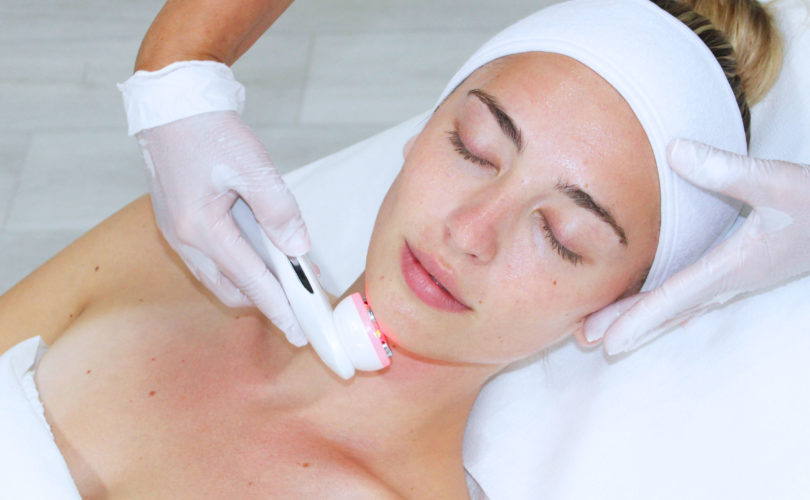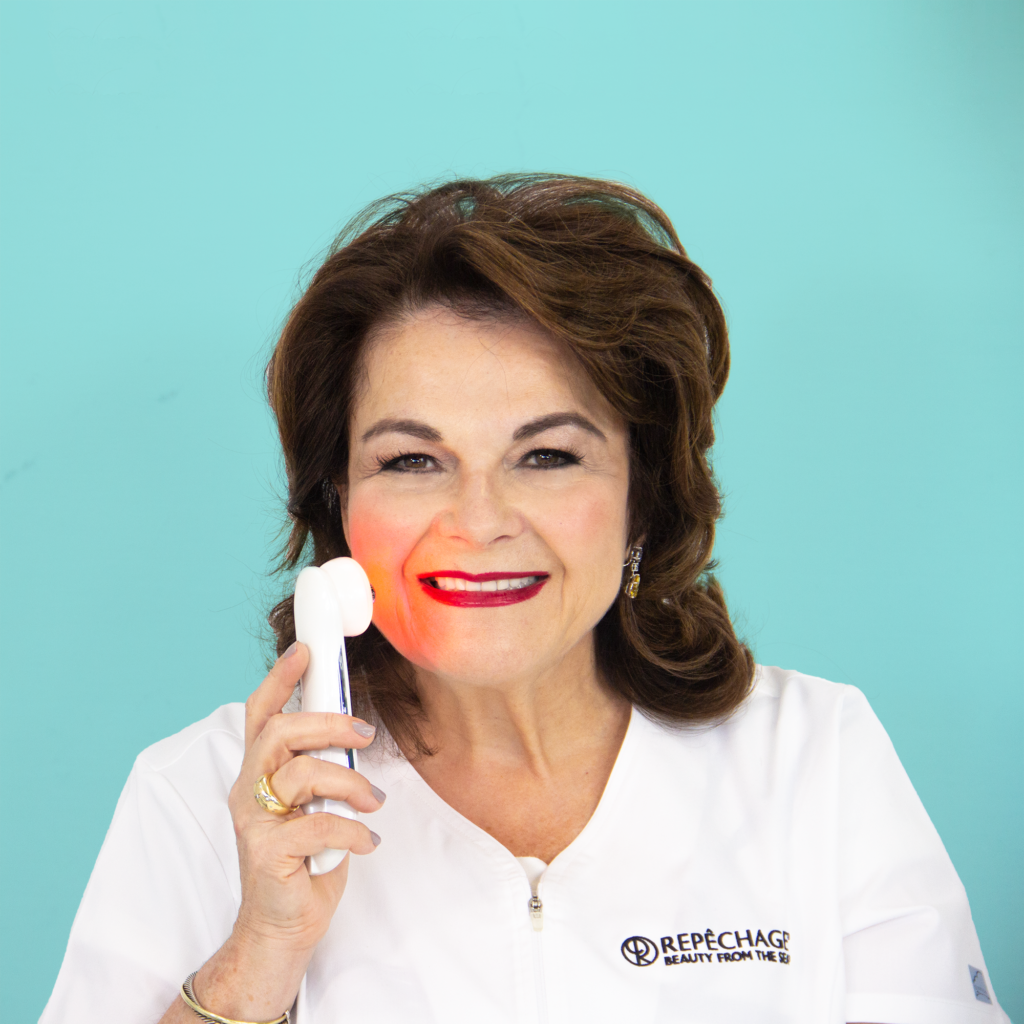 According to Mintel, in the US, 75% of female consumers currently use, or are interested in trying, a skin care device. These electronic implements can have multiple of benefits to the skin, including helping boost the efficacy of the products used during the treatment, and helping to stimulate the surface skin layers.
According to Mintel, in the US, 75% of female consumers currently use, or are interested in trying, a skin care device. These electronic implements can have multiple of benefits to the skin, including helping boost the efficacy of the products used during the treatment, and helping to stimulate the surface skin layers.
Not all devices are for the consumer, however. Some medical practitioners caution against using devices that are invasive or puncture the skin, even if marketed for at home use. According to Natalya Fazylova, DNP of ReBalance Integrative Medicine and Anti-Aging Center in NYC, treatments such as microneedling should only be done by a qualified doctor or nurse in a medical setting.
Each device also has unique contraindications, which can include pre-existing conditions such as pregnancy, open lesions, high blood pressure, asthma, metal implants or excessive fillings, rosacea, pacemakers, advanced diabetes, medications such as Accutane, and epilepsy. It is for this reason that it is always advised that devices be used by professional estheticians and at-home through professional advice and recommendation.
When it comes to which type of modality to use, the answer depends on the desired benefits. In general, Microcurrent works by stimulating the muscles of the face, helping with the structural firmness of the skin. Cosmetically, Microcurrent is generally considered an option for maintenance, versus choosing an invasive treatment such as plastic surgery or injections. Electrical Muscle Stimulation (EMS) sends pulsing current specifically to the muscle, causing it to periodically contract and relax. In medical use, EMS is considered the safest electric current therapy.
LED treatment or light therapy can provide a wide array of benefits, from assisting in the penetration of the product to helping reduce the appearance of oil on the skin. It is for this reason that the Repêchage® LED Radio Frequency and EMS Skin Tightening Machine is a one-stop-shop for skin care, combining the benefits of LED, Radio Frequency, EMS, Mesoporation and Electroporation.
Here, we will look at the benefits of LED in conjunction with EMS versus using microcurrent alone.
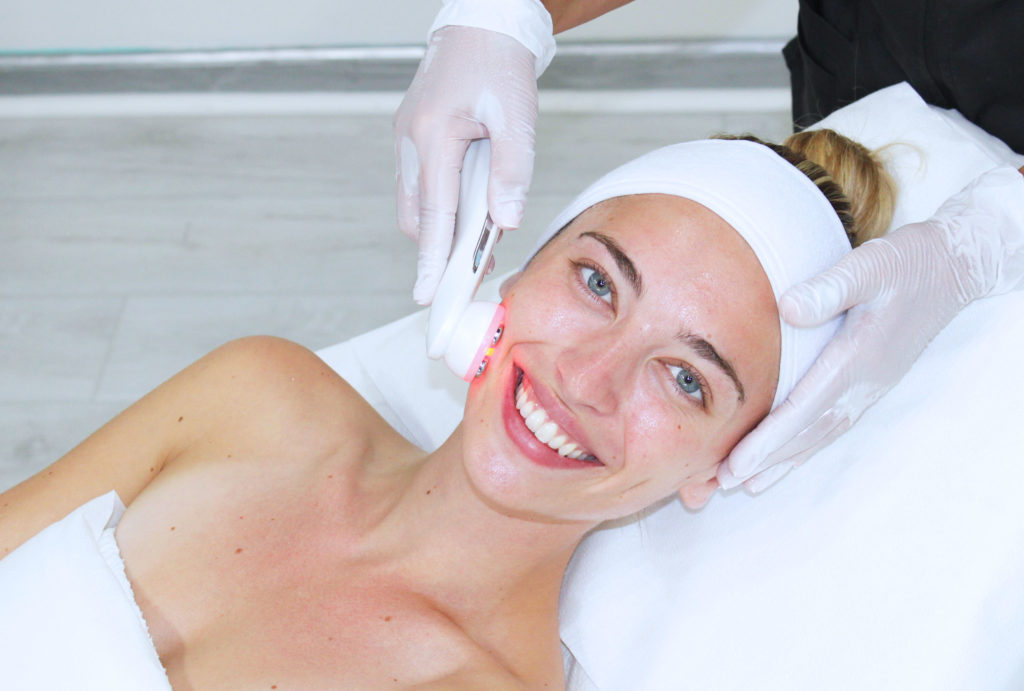 LED
LED
LED stands for Light Emitting Diodes, which are semiconductors that convert electrical energy in light wavelengths in specific ranges to have specific effects on the skin.
Light therapy is one of the oldest therapeutic treatments to address various health conditions. Sunlight benefits in treating skin diseases have been used for thousands of years in ancient Egypt, India, and China. Solar therapy was later rediscovered by Niels Ryberg Finsen, a Danish physician and scientist who won the Nobel Prize in Physiology in 1903 in recognition of his contribution to the treatment of diseases using phototherapy.
LEDs are complex semiconductors that convert electrical current into narrow spectrum light. Initial work in this area was mainly developed by National Aeronautics and Space Administration (NASA). NASA research came about as a result of the effects noted when light of a specific wavelength was shown to accelerate plant growth.
In the same way that plants use chlorophyll to convert sunlight into plant tissue, LEDs can trigger natural intracellular photobiochemical reactions. To have any effect on a living biological system, LED-emitted photons must be absorbed by a molecular chromophore or photoacceptor. Light, at appropriate doses and wavelengths, is absorbed by chromophores such as porphyrins, flavins, and other light-absorbing components within the mitochondria and cell membranes of cells.
A significant difference between lasers and LEDs is the way the light energy is delivered. The peak power output of LEDs is measured in milliwatts, whereas that of lasers is measured in watts. LEDs provide a much gentler delivery of the same wavelengths of light compared to lasers and at a substantially lower energy output.
LEDs do not have enough power to cause tissue damage and do not have the same risk of accidental eye damage that lasers do. LED light therapy has been deemed a nonsignificant risk by the Food and Drug Administration. Other advantages over lasers include the possibility to combine wavelengths with an array of various sizes. LED disperses over a greater surface area than lasers and can be used where large areas are targeted, resulting in a faster treatment time.
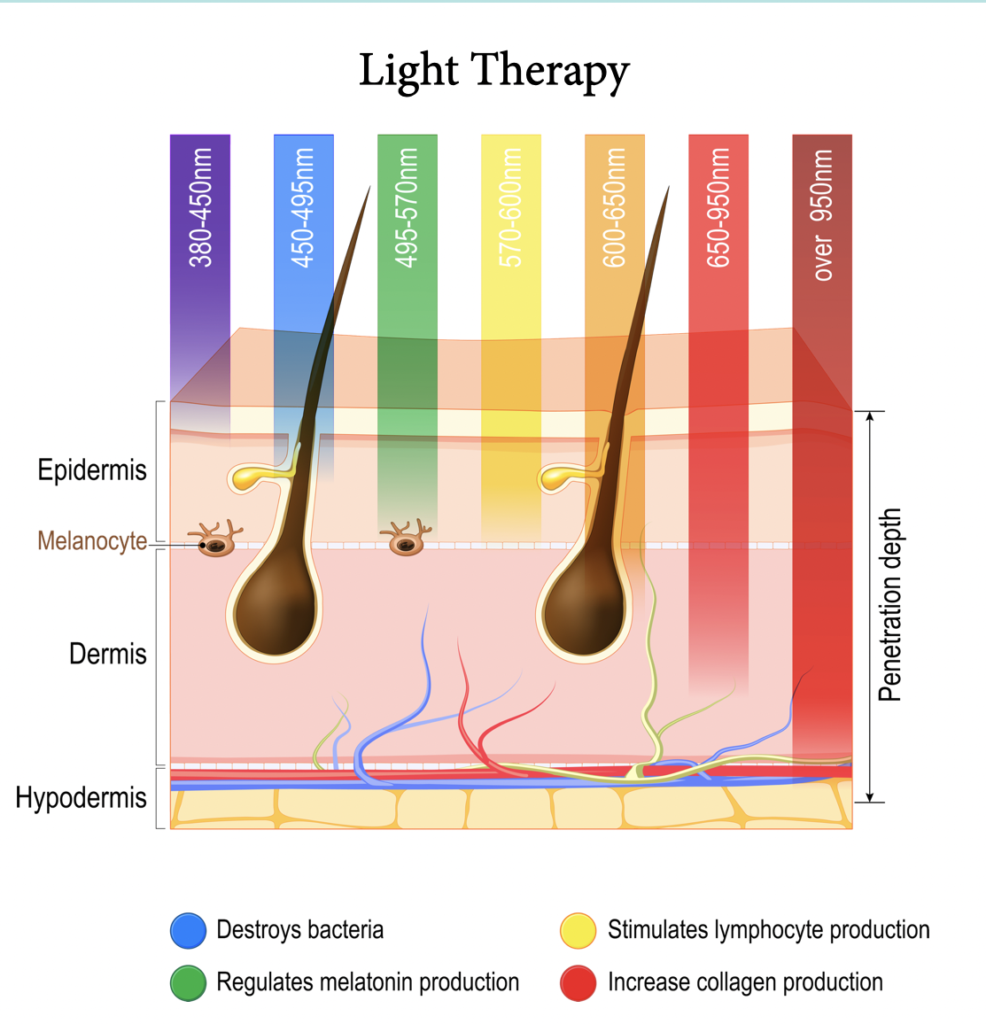 LED light works by sending energy in wavelengths between 390–1,100 nm into the surface layers of the skin either continuously or pulsed. Studies have found that wavelengths in the range of 390 nm to 600 nm are used to treat superficial tissue, and longer wavelengths in the range of 600nm to 1,100nm are used to treat deeper seated tissues.
LED light works by sending energy in wavelengths between 390–1,100 nm into the surface layers of the skin either continuously or pulsed. Studies have found that wavelengths in the range of 390 nm to 600 nm are used to treat superficial tissue, and longer wavelengths in the range of 600nm to 1,100nm are used to treat deeper seated tissues.
Studies have also found that LED therapy can result in reduced inflammatory response in acne, reduce sebum production and pore size, and may increase collage production.
The various cell and tissue types in the body have their own unique light absorption characteristics, each absorbing light at specific wavelengths. For best effects, the wavelength used should allow for optimal penetration of light in the targeted cells or tissue. Red light can be used successfully for deeper localized target (eg, sebaceous glands), and blue light may be useful for the treatment of skin conditions located within the epidermis in photodynamic therapy (PDT) (eg, actinic keratoses). To reach as many fibroblasts as possible, which is often the aim of LED therapy, a deeply penetrating wavelength is desirable. At 660 nm, for instance, light can achieve such a goal reaching a depth of 2.3 mm in the dermis, therefore covering fibroblasts up to the reticular dermis.
With the LED Radio Frequency and EMS Skin Tightening Machine, each LED wavelength or color of light provides a unique benefit to the skin. Red LED Light Treatment (620nm) is used to lessen the appearance of fine lines and wrinkles and enhance the moisturization of the skin. Green LED Light Treatment (520nm) is used to help lessen the appearance of dark spots or sallow, discolored skin. Blue LED Light Treatment (415nm) is used to lessen the appearance of oiliness and problem areas. Yellow LED Light Treatment (590nm) is used to brighten the appearance of the skin. Pink LED Light Treatment (700nm) is used to reduce the appearance of sallow, dull skin, while a flashing pink LED Light Treatment Pink flashing LED light is used to help deliver skin ingredients to the surface layers of the skin. This hand held unit allows for other areas of the body to be treated, including the décolleté, hands or feet.
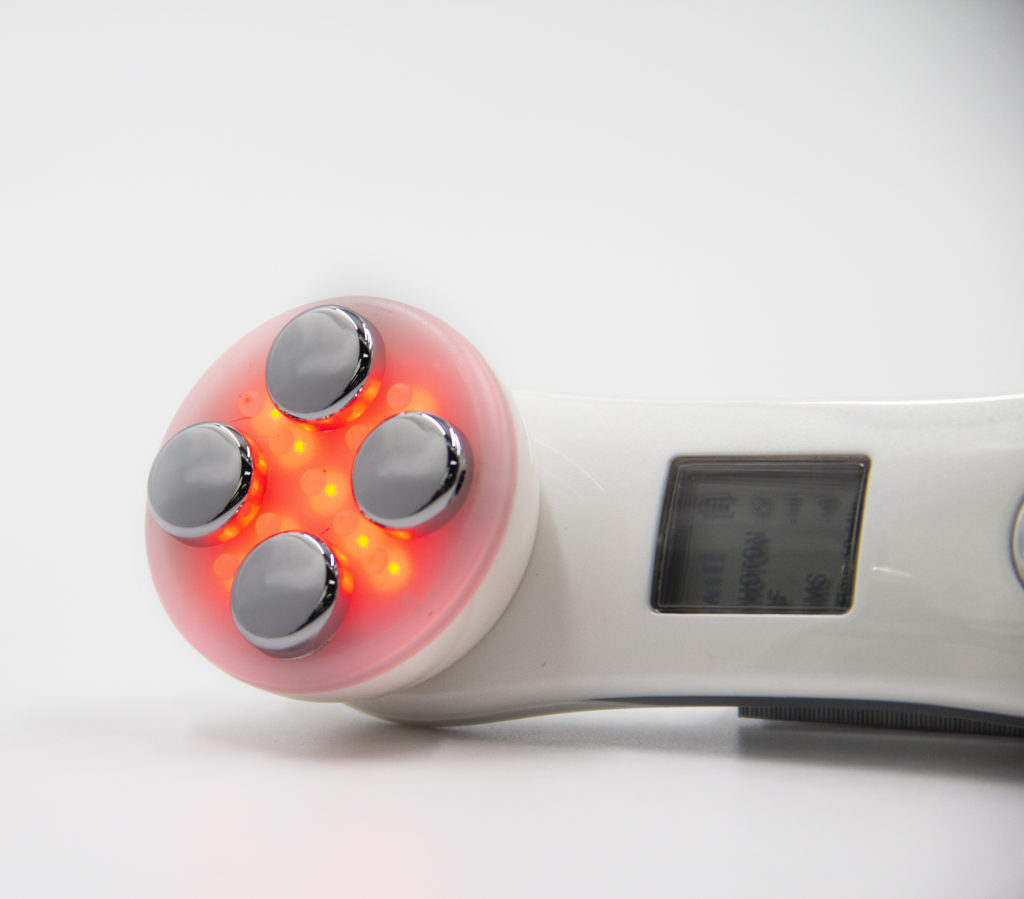
Electrical Muscle Stimulation (EMS):
At the cellular level, bioelectricity is involved in the transport through the membrane of ions that can influence cell behavior. Cells can be induced to migrate by the application of small electric impulses fields. When used at certain frequencies, it can promote the growth of capillaries, and can promote changes in the composition of muscle fibers, promote glucose absorption, increase oxidase activity, and also stimulate the growth of muscle fibers.
EMS sends pulsing current specifically to the muscle, causing it to periodically contract and relax. EMS can be used to deter muscle atrophy and improve overall muscle tone or treat conditions such as chronic or recurrent muscle spasms. EMS is a technique widely used in sports training and clinical medicine. In principle, it generates muscle contraction by activating motor axons around the electrical stimulation location.
EMS, or electrical muscle stimulation, can be a more effective modality in skin care. With the LED Radio Frequency and EMS Skin Tightening Machine, this provides gentle electrical stimulation to the skin surface to help improve the appearance of skin elasticity, soften the appearance of wrinkles and leave skin looking smooth and healthy.
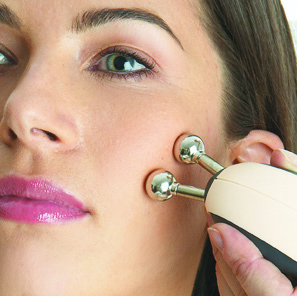
Microcurrent
This modality provides electrical impulses to the facial muscles. This type of therapy, sometimes considered a face workout or “gym”, has become popular both in spas and salons and at home to help firm the appearance of facial contours, improve the appearance of skin elasticity and soften the appearance of wrinkles.
Microcurrent devices typically come with two probes that may have electrodes at the ends. These probes are applied to the area of concern with specific directional movements, from the base of the muscle outward toward the origin and insertion for lengthening of the muscle, while tightening involves stationing a probe at the origin of the muscle while the second probe moves from the insertion to the origin. In this way, microcurrent can help with sagging lines in specific areas of the face, “lift” the appearance of the brows, help to tighten the appearance of the jawline.
Education is the best way for the esthetician to make the correct choices in using various modalities in conjunction with topical skin care. It is for this reason that Repêchage conducts ongoing education both online and at the Lydia Sarfati Post Graduate Skincare Academy. For a full list on classes, see the Educational Calendar at pro.repechage.com
What modalities do you like to use at your spa or salon? Let us know in the comments.
